高三英语构词法重点专题构词法归纳知识点分析
高三英语一轮复习语法第1讲名词的数格构词法考点讲义
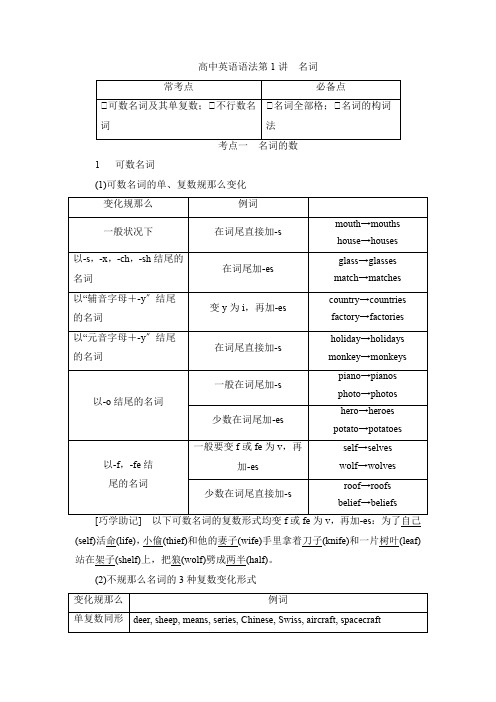
高中英语语法第1讲名词1 可数名词(1)可数名词的单、复数规那么变化:为了自己(self)活命(life),小偷(thief)和他的妻子(wife)手里拿着刀子(knife)和一片树叶(leaf)站在架子(shelf)上,把狼(wolf)劈成两半(half)。
(2)不规那么名词的3种复数变化形式一种鱼时,其单复数形式相同。
(2)people指“人们〞时单复数同形;指“民族〞时,其复数为peoples。
(3)合成名词的2种复数形式①假设有中心词,那么把中心词变成复数;假设无中心词,那么把最终一个词变成复数。
passerby→passersby, sisterinlaw→sistersinlaw, grownup→grownups①“man/woman+n.〞变复数时,作定语的man/woman和中心词都要变复数,如women engineers。
对点练1写出以下名词的复数形式①sheep—sheep①dish—dishes①knife—knives①story—stories①tomato—tomatoes2 不行数名词(1)常见的不行数名词一般来说,物质名词和抽象名词是不行数的,因此没有复数形式,一般也不能用a或an修饰。
通常只用作不行数的名词有:milk, music, homework, housework, weather, news, butter, information, bread, advice, progress, orange(橙汁), meat, equipment, fun, luggage, luck, work(工作), traffic, furniture, wealth, word(消息), room(空间), man(人类)等。
[名师点津]word意为“消息〞、room意为“空间〞、man意为“人类〞时,通常不带任何修饰词。
高中英语:构词法语法知识点

高中英语:构词法语法知识点许多英语单词的构成都有一定的规律,这种规律被称为构词法。
掌握构词法知识对我们更好地理解词义、认识新词和扩大词汇量有重要意义。
英语中的构词法主要有派生法(Derivation)、合成法(Composition)和转换法(Conversion)三大类。
构词法一派生法在一个词的词根(root)前面或后面加上某个词缀(affix)来产生新词,这种构词法称为派生法(derivation)或词缀法(affixation)。
加在前面的词缀叫前缀(prefix),加在后面的词缀叫后缀(suffix)。
一般情况下,前缀往往改变词根的词义,不改变词根的词性;而后缀往往改变词根的词性,有些也涉及意义的变化。
大部分前缀和后缀都有固定的意义,因而许多派生词的词义可以通过词根及词缀的意思推知。
1. 形容词变副词的后缀2.形容词变名词的后缀3.动词变名词的后缀4.表示"人"的后缀在某些形容词、名词或动词后面加后缀变成具有某种职业或动作的人。
常见的表示"人"的后缀有:5.动词、名词变形容词的常见后缀6.表示否定或相反意义的前缀和后缀7.变动词的前缀和后缀构词法二转化法在词形不变的情况下,把一个单词由一种词性转换成另一种词性,而没有加任何词缀,这种构词方法称为转换法。
转换法种类很多,但数量最多的是由名词转化为动词和由动词转化为名词两大类。
转换后的词义与转换前的词义通常有密切的联系,但有时差异也很大。
构词法三合成法把两个或两个以上的词素放到一起,这种构词法称为合成法。
合成词通常由两个或两个以上的自由词素构成不同词性,最常见的包括:名词合成词,形容词合成词,动词合成词。
之间有的用连字符连接,有的直接连接在一起。
1.合成名词2.合成形容词3.合成动词4.合成副词5.合成代词。
高中英语构词法讲解
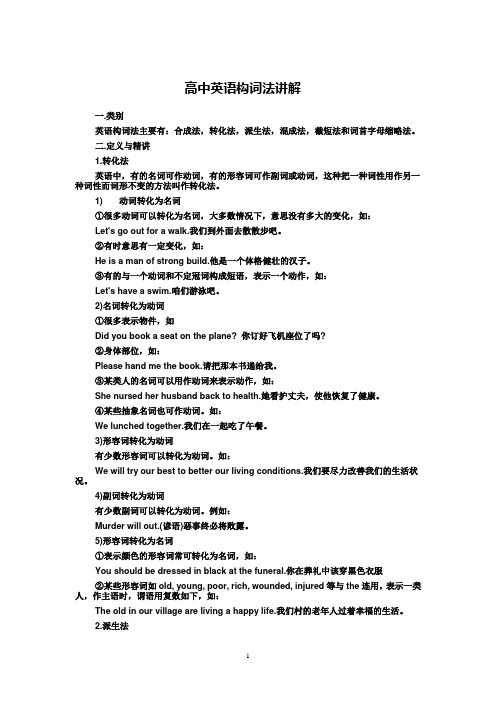
高中英语构词法讲解一.类别英语构词法主要有:合成法,转化法,派生法,混成法,截短法和词首字母缩略法。
二.定义与精讲1.转化法英语中,有的名词可作动词,有的形容词可作副词或动词,这种把一种词性用作另一种词性而词形不变的方法叫作转化法。
1) 动词转化为名词①很多动词可以转化为名词,大多数情况下,意思没有多大的变化,如:Let's go out for a walk.我们到外面去散散步吧。
②有时意思有一定变化,如:He is a man of strong build.他是一个体格健壮的汉子。
③有的与一个动词和不定冠词构成短语,表示一个动作,如:Let's have a swim.咱们游泳吧。
2)名词转化为动词①很多表示物件,如Did you book a seat on the plane? 你订好飞机座位了吗?②身体部位,如:Please hand me the book.请把那本书递给我。
③某类人的名词可以用作动词来表示动作,如:She nursed her husband back to health.她看护丈夫,使他恢复了健康。
④某些抽象名词也可作动词。
如:We lunched together.我们在一起吃了午餐。
3)形容词转化为动词有少数形容词可以转化为动词。
如:We will try our best to better our living conditions.我们要尽力改善我们的生活状况。
4)副词转化为动词有少数副词可以转化为动词。
例如:Murder will out.(谚语)恶事终必将败露。
5)形容词转化为名词①表示颜色的形容词常可转化为名词,如:You should be dressed in black at the funeral.你在葬礼中该穿黑色衣服②某些形容词如old, young, poor, rich, wounded, injured等与the连用,表示一类人,作主语时,谓语用复数如下,如:The old in our village are living a happy life.我们村的老年人过着幸福的生活。
构词法专题 重要考点及解题技巧

语法专项2——构词法掌握一定的构词法知识,有助于系统扩大词汇量,降低阅读中的生词量,使阅读更流畅。
构词法也是高考语法填空题及改错题的重要考点。
一、三种主要构词法英语主要有三种构词法,即转化法、合成法和派生法。
1. 转化法就是把一个词从一种词类转化为另一种词类。
如:You can water the flowers with dirty water. 你可以用脏水浇花。
2. 合成法就是把两个或两个以上的词结合成一个新词。
如:Few people realized that dustmen were doing an important job.清洁工人3. 派生法就是将一个单词附加前缀或后缀,变为一个新单词。
前缀附加在单词前面,一般不改变原词的词类,但会引起词义的变化。
后缀附加在单词后面,一般不改变原词的基本含义,但会引起词类的变化。
如:We think it impossible to finish the work on time.My grandpa looks very healthy.二、近三年全国III卷高考语法填空及改错构词法考点呈现。
1.语法填空。
(1)(2018) I’m a 66 ______(science) who studied animals such as apes and monkey.(2)(2017) She is determined to carry on with her 66______________________(educate).It is 70___________(certain) fun but the lifestyle is a little unreal.(3)(2016) Food in small pieces could be eaten easily with twigs which 66____________(gradual)turned into chopsticks.Confucius, 67 who lived from roughly 551 to 479 B.C., influence the 68________(develop) of chopsticks.2.改错。
专题 17 高考英语语法【构词法】核心考点聚焦 -高考英语必背手册

高考英语必背手册
专题十七构词法
对于高中生来说,词汇无疑是一个不容忽视的重要问题。
面对教材中大量的英语词汇和做题时题目中出现的新词汇,学生常常显得无所适从,苦于记忆单词效率低,遗忘速度快。
而了解英语构词法,掌握一定数量的构词成分,则是开启英语词汇大门的钥匙。
英语词汇的数量已超过百万,但构词成分却很有限,构词方法则更有限。
英语词汇的构成有一定的规律和法则。
按照其规律和法则造词的方法就叫构词法。
英语词汇构词法的常用的主要类型,比如词缀法、转类法、复合法、混成法、逆生法、截短法等。
通过构词法的学习,便于我们巩固和扩大英语词汇量,有利于我们学好,用好,教好英语这门语言。
掌握英语构词法是学生应该具备的一项基本技能,它对于帮助学生扩大词汇量,准确地推测文章中的词汇的含义和理解文章都具有重要的意义。
教师应积极引导学生归纳、总结英语构词法,以便促进学生积极学习英语和提高学生学习英语的效率。
第一类派生词
第三类合成法。
高考英语语法必考考点(15)构词法(含解析)
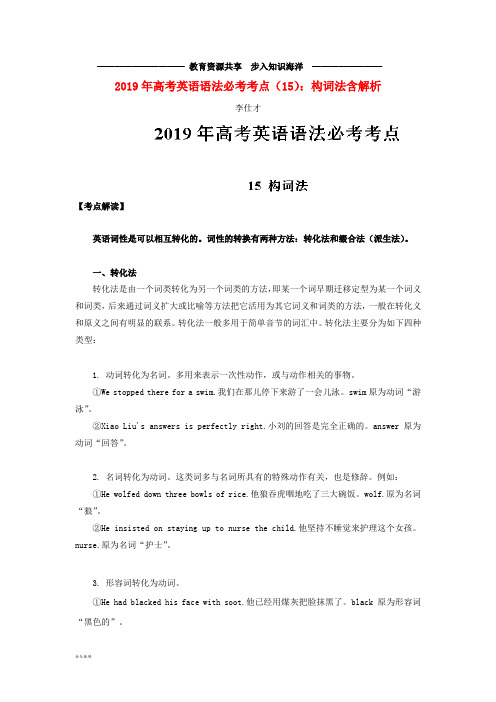
——————————教育资源共享步入知识海洋————————2019年高考英语语法必考考点(15):构词法含解析李仕才【考点解读】英语词性是可以相互转化的。
词性的转换有两种方法:转化法和缀合法(派生法)。
一、转化法转化法是由一个词类转化为另一个词类的方法,即某一个词早期迁移定型为某一个词义和词类,后来通过词义扩大或比喻等方法把它活用为其它词义和词类的方法,一般在转化义和原义之间有明显的联系。
转化法一般多用于简单音节的词汇中。
转化法主要分为如下四种类型:1. 动词转化为名词。
多用来表示一次性动作,或与动作相关的事物。
①We stopped there for a swim.我们在那儿停下来游了一会儿泳。
swim原为动词“游泳”。
②Xiao Liu's answers is perfectly right.小刘的回答是完全正确的。
answer原为动词“回答”。
2. 名词转化为动词。
这类词多与名词所具有的特殊动作有关,也是修辞。
例如:①He wolfed down three bowls of rice.他狼吞虎咽地吃了三大碗饭。
wolf.原为名词“狼”。
②He insisted on staying up to nurse the child.他坚持不睡觉来护理这个女孩。
nurse.原为名词“护士”。
3. 形容词转化为动词。
①He had blacked his face with soot.他已经用煤灰把脸抹黑了。
black 原为形容词“黑色的”。
②My father is emptying a box of rubbish into a rubbish-cart.我爸爸正将垃圾倒入垃圾车。
empty原为形容词“空的”。
4. 形容词转化为名词。
即用性质来指代这种性质的事物。
例如:①My mother likes red.我妈妈喜欢红色(的)。
red原为形容词“红色的”。
②The Chinese are working-hard and brave people.中国人勤劳而勇敢。
英语构词法归纳和总结
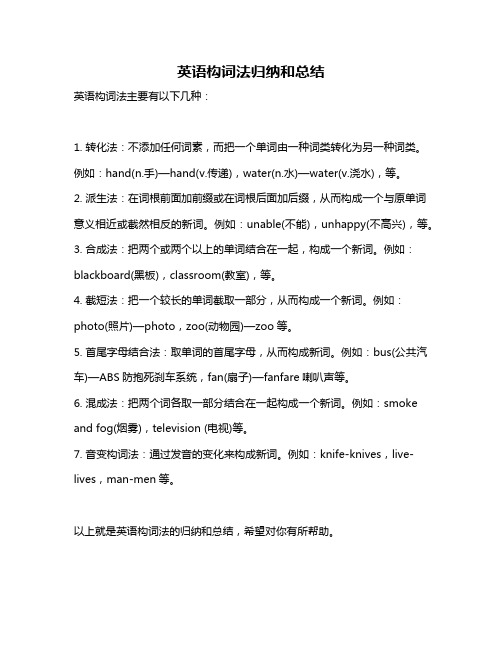
英语构词法归纳和总结
英语构词法主要有以下几种:
1. 转化法:不添加任何词素,而把一个单词由一种词类转化为另一种词类。
例如:hand(n.手)—hand(v.传递),water(n.水)—water(v.浇水),等。
2. 派生法:在词根前面加前缀或在词根后面加后缀,从而构成一个与原单词意义相近或截然相反的新词。
例如:unable(不能),unhappy(不高兴),等。
3. 合成法:把两个或两个以上的单词结合在一起,构成一个新词。
例如:blackboard(黑板),classroom(教室),等。
4. 截短法:把一个较长的单词截取一部分,从而构成一个新词。
例如:photo(照片)—photo,zoo(动物园)—zoo等。
5. 首尾字母结合法:取单词的首尾字母,从而构成新词。
例如:bus(公共汽车)—ABS防抱死刹车系统,fan(扇子)—fanfare喇叭声等。
6. 混成法:把两个词各取一部分结合在一起构成一个新词。
例如:smoke and fog(烟雾),television (电视)等。
7. 音变构词法:通过发音的变化来构成新词。
例如:knife-knives,live-lives,man-men等。
以上就是英语构词法的归纳和总结,希望对你有所帮助。
关于高中英语构词法的必考考点剖析

关于高中英语构词法的必考考点剖析今天小编想和大家分享的是关于高中英语构词法的必考考点剖析,高三的同学要特别注意了,接下来就让我们一起来学习一下吧。
一. 转化法在英语中,一个单词由一种词性转化为另一种或几种词性而词形不变的方法叫做转化法。
1. 动词转化为名词●Let me have a try.让我试试。
●They are only allowed to sell soft drinks at school.在学校里只准许他们出售不含酒精的饮料。
2. 名词转化为动词●He shouldered his way through the crowd.他用肩膀推开人群前进。
●The smell from the kitchen made his mouth water.从厨房传来的气味使他流口水。
3. 形容词转化为动词●We will try our best to better our living conditions.我们要尽力改善我们的生活状况。
●They tried to perfect the working conditions.他们努力改善工作条件。
4. 形容词转化为名词●He didn’t know the difference between right and wrong.他不辨是非。
●The old in our village are living a happy life.我们村的老年人过着幸福的生活。
5. 形容词转化为副词●How long have you lived there?你在那儿住多久了?6. 个别词在一定场合中可转化为名词●Warm clothes are a must in the mountains.穿暖和的衣服到山区去是必须的。
●Life is full of ups and downs.人生有得意时也有失意时。
●His argument contains too many ifs and buts.他的辩论中含有太多的“如果”和“但是”。
英语构词法归纳总结[原创]
![英语构词法归纳总结[原创]](https://img.taocdn.com/s3/m/b5c3db65af1ffc4fff47ac0f.png)
英语构词法英语主要有三种构词法:转化、派生和合成,下面简要介绍一下这三种构词法。
1、转化构词法:①有大量的动词可以转化为名词,有时意思没有太大的变化:Let me have a try.我来试一试。
We stopped there for a swim.He went off at a run to consult a doctor.This is for winter wear. Don’t make it too tight.I like a quiet read after supper。
This was a great surprise(strike,shock)to my brother.Have a look(chat,talk,wash,swim,rest,try,quarrel,smoke,lie,read,run,dream,fight,walk,ride,drink,laugh,dance,bathe,wish,win,fear,love,debate,dispute,interview,taste,etc)Make a study(guess,visit,call,survey,jump,slip,change,search,stay,smart,answer,reply,remark,fight,arrest,appeal,purchase,sacrifice,demand,show,deal,attempt,attack,advance,etc)Come to a stop(end,pause)有时意思有一定的变化:He was about the same build as his brother.他的体形和他哥哥差不多。
Last year`s catch was four times that of 1986.去年的捕鱼量为1986年的四倍。
This was a decisive move.这是一个决定性的步骤。
高三英语构词法重点专题构词法归纳知识点分析
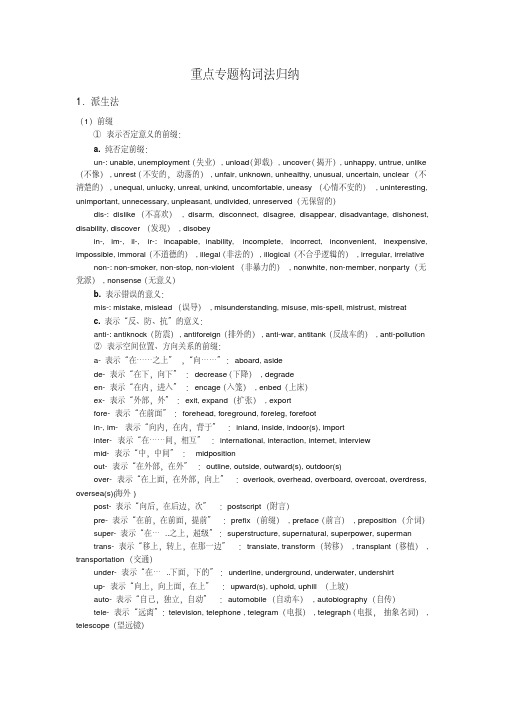
重点专题构词法归纳1.派生法(1)前缀①表示否定意义的前缀:a. 纯否定前缀:un-: unable, unemployment(失业), unload(卸载), uncover(揭开), unhappy, untrue, unlike (不像), unrest(不安的,动荡的), unfair, unknown, unhealthy, unusual, uncertain, unclear(不清楚的), unequal, unlucky, unreal, unkind, uncomfortable, uneasy(心情不安的), uninteresting, unimportant, unnecessary, unpleasant, undivided, unreserved(无保留的)dis-: dislike(不喜欢), disarm, disconnect, disagree, disappear, disadvantage, dishonest, disability, discover(发现), disobeyin-, im-, il-, ir-: incapable, inability, incomplete, incorrect, inconvenient, inexpensive, impossible, immoral(不道德的), illegal(非法的), illogical(不合乎逻辑的), irregular, irrelative non-: non-smoker, non-stop, non-violent(非暴力的), nonwhite, non-member, nonparty(无党派), nonsense(无意义)b. 表示错误的意义:mis-: mistake, mislead(误导), misunderstanding, misuse, mis-spell, mistrust, mistreatc. 表示“反、防、抗”的意义:anti-: antiknock(防震), antiforeign(排外的), anti-war, antitank(反战车的), anti-pollution②表示空间位置、方向关系的前缀:a- 表示“在……之上”,“向……”:aboard, asidede- 表示“在下,向下”:decrease(下降), degradeen- 表示“在内,进入”:encage(入笼), enbed(上床)ex- 表示“外部,外”:exit, expand(扩张), exportfore- 表示“在前面”:forehead, foreground, foreleg, forefootin-, im- 表示“向内,在内,背于”:inland, inside, indoor(s), importinter- 表示“在……间,相互”:international, interaction, internet, interviewmid- 表示“中,中间”:midpositionout- 表示“在外部,在外”:outline, outside, outward(s), outdoor(s)over- 表示“在上面,在外部,向上”:overlook, overhead, overboard, overcoat, overdress, oversea(s)(海外)post- 表示“向后,在后边,次”:postscript(附言)pre- 表示“在前,在前面,提前”:prefix(前缀), preface(前言), preposition(介词)super- 表示“在…..之上,超级”:superstructure, supernatural, superpower, superman trans- 表示“移上,转上,在那一边”:translate, transform(转移), transplant(移植), transportation(交通)under- 表示“在…..下面,下的”:underline, underground, underwater, undershirtup- 表示“向上,向上面,在上”:upward(s), uphold, uphill(上坡)auto- 表示“自己,独立,自动”:automobile(自动车), autobiography(自传)tele- 表示“远离”:television, telephone , telegram(电报), telegraph(电报,抽象名词), telescope(望远镜)③表示时间,序列关系的前缀:fore- 表示“在前面,先前,前面”:foreword(前言), forecast(预报), foretell(预言), foresee(预见), foreknow(先知), foreknowledge(先知)mid- 表示“中,中间”:midnight, midsummer, mid-day, mid-autumnpost- 表示“在后,后”:postwar, postgraduate(研究生), postdatepre- 表示“在前,事先,预先”:preheat, prewar, prehistory(史前), preview(预习), prebattle, prepayre- 表示“再一次,重新”:retell(复述), rewrite, renew(续借), reconsider, reuse, remarry, recycle(回收利用), rebuild④表示比较程度差别关系的前缀:by- 表示“副,次要的”:byproduct(副产品), bywork(副业)extra- 表示“超越,额外”:extraordinaryover- 表示“超过,过度,太”:overeat(吃过多), oversleep(睡过头), overpraise(过奖), overwork, overact(行为过分), overdounder- 表示“低劣,低下”:undersize, undergrown, underproduction(生产不足)vice- 表示“副,次”:vice-president, vice -chairman⑤表示共同,相等意思的前缀:co- 表示“共同,一起”:coexist(共同生存), co-operate, co-worker, coactions(合作行动), coauthor(合作作者)⑥表示某种状态,构成形容词、副词或动词:a- afraid, alive, alone, asleep, ashamed, aloud, ahead, aside, alike, awake⑦表示分离,离开意思的前缀:a- 表示“分离,离开”:away, apartde- 表示“离去,处去”:depart, decolour⑧表示“自我”:self- self-protect(ion), self-made, self-knowledge⑨表示变换词类作用的前缀:be- befrienden- enslave, enable, enrich, enlarge, encourage⑩表示数量关系的前缀:a. 表示“单一”,“一”:uni- uniform(统一服装), unicellular(单细胞)b. 表示“二,两,双”:bi- bicycletwi- twilightc. 表示“半,一半”:semi- semiconductor(半导体), semicircle(半圆), semimonthly(半月刊), semifinal (半决赛)d. 表示“百,百分之一”:centi- centimetere. 表示“千,千分之一”:kilo- kilometer, kilogram, kilowattf. 表示“微小”:micro- microvolt(微伏特), microcomputer(微机), microscope(显微镜)g. 表示“许多,复,多数”:multi- multimedia(多媒体), multicolored, multiform, multinaturalh. 表示“千分之一、毫”:milli- millimeter, milligrami. 表示“微小、微型”:mini- minibus, miniskirt, minipark(2)后缀①名词后缀:a. 具有某种职业或动作的人:-an, -ian, -ician 表示“……地方的人,精通……的人”:American, Asian, Australian, Russian, Italian , historian, librarian, electrician, magician(魔术师), technician, musician, politician(政客), physician(内科医生),-ant,-ent 表示“……人”:merchant, servant, assistant, agent, student,-ee 表示“动作承受者”:employee(雇员), examinee, payee(收款人), interviewee -eer 表示“从事于……人”:engineer, volunteer(志愿者)-er 表示“从事某种职业的人, 某地区,地方的人”:banker, observer, Londoner, villager singer, driver, writer, speaker, traveller, buyer-or 表示“……者”:author, doctor, operator, actor, visitor, inventor, educator-ar, -ary 表示“……的人, 从事……的人”:scholar, liar, beggar, secretary, missionary -ese 表示“……国人,……地方的人”:Chinese, Japanese, Cantonese(广东人)-ess 表示“阴性人称名词”:actress(女演员), hostess(女主人), manageress(女经理)-ist 表示“从事……研究者,信仰……主义者”:pianist, communist, dentist, artist, chemist, socialist, typist, receptionist-icist 表示“……家,……者, ……能手”:physicist, phoneticist(语音学家), technicist -logist 表示“……学家,研究者”:biologist, geologist(地质学家)b. 构成具有抽象名词的含义:-age 表示“状态,行为,身份及其结果,总称”:courage, storage, marriage, percentage -al 表示“事物的动作,过程”:refusal, arrival, survival, denial, approval, trial, burial-ance, -ence 表示“性质,状况,行为,过程,总量,程度”:importance, distance, avoidance, appearance, performance, diligence, difference, obedience, absence, presence(出席), existence -ancy, -ency 表示“性质,状态,行为,过程”:frequency(频繁), urgency(紧急), efficiency (高效率),-ity 表示“性质,状态,程度”:purity, reality, equality-bility 表示“动作,性质,状态”:ability, possibility, probability, responsibility-dom 表示“等级,领域,状态”:freedom, kingdom, wisdom-ery, -ry 表示“行为,状态,习性,性质”:bravery, slavery-hood 表示“资格,身份, 年纪,状态”:childhood, girlhood, boyhood, manhood-ice 表示“行为,性质,状态”:notice, justice, service-ing 表示“动作的过程,结果”:building, writing, learning-ion, -ation, -ition, -sion 表示“行为的过程,结果,状况”:suggestion, action, solution, invention, direction, correction, collection, instruction, destruction, introduction, congratulation, dictation, invitation, pronunciation, examination, graduation, operation, education, information, translation, starvation, satisfaction, relation, irrigation, determination, preparation, imagination, explanation, opposition, competition, description, decision, division, conclusion, explosion,impression, expression, admission, permission, discussion-ment 表示“行为,状态,过程,手段及其结果”:disappointment, treatment, movement, judgment, punishment, argument, agreement, government, development, improvement, requirement, astonishment, encouragement-ness 表示“性质,状态,程度”:goodness, kindness, tiredness, friendliness, business, illness, happiness, goodness, willingness, weakness, fairness-ism 表示“制度,主义,学说,信仰,行为”:socialism, criticism, heroism, tourism, communism(共产主义), Marxism(马克思主义)-ship 表示“情况,性质,技巧,技能及身份,职业”:hardship, relationship, membership, friendship, seamanship, ownership, scholarship, professorship-th, 表示“动作,性质,过程,状态”:strength, length, width, depth, wealth, truth, growth, warmth, youth-ure 表示“行为,结果”:exposure(暴露), pressure, failure, procedure(手续), mixture -craft 表示“工艺”:aircraft, needlecraft, woodcraftc. 带有场所,地方的含义:-age 表示“住所,地点”:village, cottage-ary 表示“住所,场地”:library, granary (谷仓)-ory 表示“工作场所,住处”:factory, dormitory, laboratory, observatory②形容词后缀:a. 带有“属性,倾向,相关”的含义:-able, -ible: movable, comfortable, eatable, enjoyable, acceptable, reasonable, applicable, visible, responsible, terrible, horrible-al: natural, additional, educational, national-ant, -ent: distant, important, excellent-ing(表示特征:令人觉得): moving, touching, daring, interesting, exciting, disappointing , astonishing, boring, amazing-ed(表示情绪:觉得): pleased, interested, surprised, worried, excited, bored, determined, delighted-ish: foolish, bookish, selfish-ive: active, impressive, decisive, active, instructive, expensive, progressiveb. 表示“相象,类似”的含义:-ish: boyish, childish-like: manlike, childlike-some: troublesome, handsome-y: milky, cloudy sunny, windy, rainy, foggy, healthy, wealthy, worthy, bloody, funny, dirty, lucky, noisy, salty, smelly, hilly-ly: manly, fatherly, motherly, sisterly, brotherly, daily, weekly, monthly, quarterly, yearly, friendly, lonely, orderly, lovely, lively, likely, scholarlyc. 表示“充分的”含义:-ful: beautiful, wonderful, helpful, truthful, successful, harmful, useful, careful, forgetful, merciful-ous: dangerous, courageous, nervous, mountainous, humorous, variousd. 表示由某种物质形成,制成或生产的含义:-en: wooden, golden, woolene. 表示方向的含义:-ern: eastern, western, southern, northern, southeastern, northwestern-ward: downward, forwardf. 表示“数量关系”的含义:-teen: thirteen-ty: fifty-th: fourth, fiftiethg. 表示国籍,语种,宗教的含义:-an: Roman, European-ese: Chinese, Japanese-ish: English, Spanishh. 表示否定:-less: countless, stainless(不锈的), wireless, useless, endless, priceless(无价的,贵重的), hopeless③动词后缀:-ize, ise 表示“做成,变成,……化”:modernize(现代化), democratize(民主化), organize, apologize, realize-en 表示“使成为,引起,使有”:quicken, weaken, soften, harden-fy 表示“使……化, 使成”:beautify, purify(净化), intensify, signify, simplify(简化), satisfy④副词后缀:-ly: possibly, swiftly, simply-ward(s): downward, inwards, upward-ways: always, sideways-wise: otherwise, clockwise注意:有的单词有双重后缀,如:use(用途)→useless(无用的)→uselessness(无用)self(自己)→selfish(自私的)→selfishness(自私)有的单词则是前后缀同时使用,如:important→importance→unimportanceregular(有规律的,有规则的)→irregular(无规律的,不规则的)→irregularity(无规律,不规则)2.合成法(1)合成名词boyfriend, girlfriend, bus-driver, necklace, playground, radioactive, headmaster, sunshine, notebook, armchair, wheelchair, postcard, football, spaceship, blackboard, firefighter, fireman, gateman, chairman, weatherman, businessman, armyman, postman, sportsman, bedroom, reading-room, classroom, newspaper, pickpocket(扒手), she-goat(雌性山羊), editor-in-chief (主编), daybreak(破晓), handshake(握手), silkworm(蚕), outbreak(爆发)(2)合成形容词名词+动词过去分词:man-made, homemade副词+动词过去分词:well-known, newly-built(新建的)形容词+名词ed:kind-hearted, cold-blooded数词+名词ed:five-storeyed(五层楼的), four-legged(四条腿的)名词+动词现在分词:English-speaking, Chinese-speaking, brainwashing(洗脑的)由三个词构成的合成形容词:face-to-face, heart-to-heart, two-year-old, eight-metre-long 其他合成形容词:everyday(日常的), faraway(遥远的), snow-white(雪白的), lay-off (下岗的)3.转化法(1)名词→动词hand(手→传递)back(背部,后面→支持,后退)charge(费用→收费)copy(抄本,复印件→抄写,复印)flood(洪水→淹没)heat(热量→加热)paint(油漆→刷漆)phone(电话→打电话)pin(别针→装订)waste(废物→浪费)face(脸→面对)use(用途→使用)interest(兴趣→使兴趣)surprise(惊讶→使惊讶)taste(味道→品尝)smell(气味→闻)break(短暂休息→折断)present(礼物→赠送)(2)形容词→动词clean(干净→使干净,打扫)clear(清楚→清理)dirty(脏→弄脏)dry(干燥→烘干,晒干)empty(空的→倒空)free(自由→使自由,释放)slow(慢的→放慢)warm(暖和→使暖和)cool(凉的→冷却)quiet(安静→使安静)。
高中英语专题-构词法

构词法英语构词法种类英语构词法主要有:合成法,转化法,派生法,混成法,截短法和词首字母缩略法。
定义与精讲1.合成:两个单词连在一起合成一个新词,前一个词修饰或限定后一个词。
(1)名词+名词sunlight 阳光handbag手提包(2)形容词+名词blackboard黑板darkroom 暗室(3)副词/介词+名词afternoon 下午uproar 喧嚣(4)动词+名词postcard 明信片pickpocket扒手(5)名词+动名词sightseeing 观光handwriting 书法(6)动词+副词get-together聚会break-through突破(7)其他方式构成的合成名词passer-by 过路人grown-up成年人合成形容词的主要构成方式(1)名词+形容词snow-white雪白的world-famous 世界闻名的(2)形容词+名词open-air 户外的old-style 旧式的(3)名词/形容词+名词+-edkind-hearted 好心的blue-eyed 蓝眼睛的(4)名词/形容词/副词+现在分词good-looking 好看的well-written 写得好的合成动词的主要构成方式(1)名词+动词sunbathe 晒日光浴typewrite 打字(2)副词+动词underline 画底线标出overcome 克服(3)形容词+动词blacklist 将……列入黑名单whitewash 用石灰水把……刷白1)有些合成词保留了原来两个单词的意思。
keyword 关键词toothache 牙痛2)有些合成词与原来两个单词的意思区别很大。
eggplant 茄子parkway 驾车专用道注意:2.派生:是通过在词根上加前缀或者后缀构成一个新词。
前缀: 词根加前缀多数不改变词性,只改变词义。
(1)表示相反意义的前缀有:un-,in-,im-,il-,ir-,non-,dis-,mis-等。
英语构词法解析(全面总结)
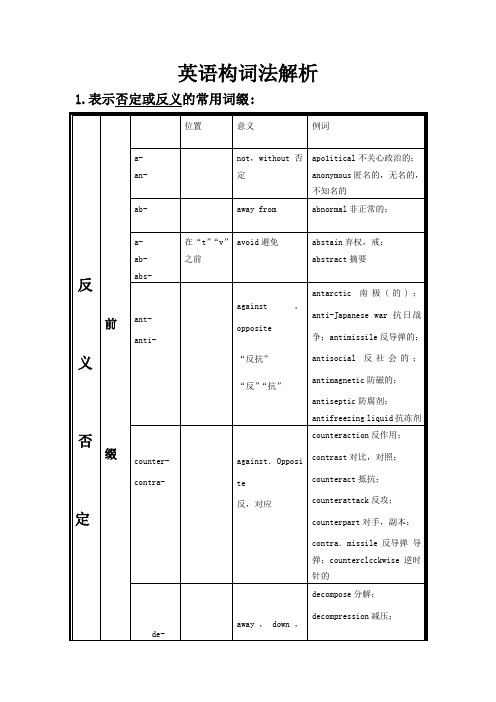
blandish讨好;
cherish爱护;
perish毁灭
-ize
-ise
-yze
-yse
加在形容词后
(v.)cause to be of have以……方式对待;……化
realize实现;
mechanize机械化;
analyse,analyze分析;
Americanize美国化;popularize推广
六
sexangle六角;
sexennial六年一度的;
sexcentenary六周年纪念
sept-
七
September九月(古罗马的七月);
septennial七年一度的
hepta-
heptad七人集团;
heptagon七角形
octa-
oct-
octo-
八
octagon八角形;
October十月;:
gangster歹徒;
trickster骗子
-al
加在动词后
(n.)act;one who;that which表动作,事物
proposal提案;
professional专业人员;
signal信号;
approval同意;
refusal拒绝;
arrival到达
-age
加在动词后
(n.)state;quality,act表状态,性质,行为,情况
di-
dioxide二氧化物;
diode二级管;
diphthong双元音
tri-
三
triangle三角形;
tripod三角架;
triennial每三年一次的;
triple三倍的;
2019年高中英语构词法归纳整理

构词法(一)名词(也有少数动词)+-y变成形容词,少意为:”多……的;像……一样的。
”有些要去掉词尾的-e,有些要先双写末尾一个字母,然后再加-y.这种构词法在英语中经常出现,掌握这个规律对词汇量的扩大能起到事半功倍的效果。
air+y=airy空气的,空中的,空想的,活泼的anger+y=angry 生气的hunger+y=hungry 饥饿的bag+y=baggy 袋状的beam+y=beamy放光的;愉快的;辐射的blood+y=bloody血腥的;出血的bone+y=bony多骨的;皮包骨头的book+y=booky书上的;书生气的boss+y=bossy专横的,爱指手划脚的brain+y=brainy 聪明的bush+y=bushy 浓密的cat+y=catty敏捷的;狡猾的;阴险的cheek+y=cheeky厚颜无耻的,不要脸的cheer+y=cheery愉快的,活泼的chill+y=chilly寒冷的;不友好的cloud+y=cloudy多云的;阴郁的cock+y=cocky趾高气扬的,骄傲自大的cream+y=creamy含大量奶油的;奶油色的dirt+y=dirty 肮脏的dog+y=doggy像狗一样的;爱玩狗的;炫耀的dream+y=dreamy梦一般的;爱空想的,理想的earth+y=earthy泥土(似)的;朴实的,现实的edge+y=edgy 锋利的fat+y=fatty肥胖的;油腻的fault+y=faulty有错误的,有缺点的feather+y=feathery羽毛似的;轻软的fish+y=fishy 多鱼的;可疑的;无表情的flash+y=flashy闪光的;昙花一现的;华而不实的flesh+y=fleshy多肉的;肉的flower+y=flowery多花的;辞藻华丽的fog+y=foggy 多雾的fox+y=foxy 狡猾的fruit+y=fruity果味的;圆润的;洪亮的fun+y=funny 有趣的glass+y=glassy明净的;(眼)无神采的gloom+y=gloomy黑暗的;朦胧的;悲观的grass+y=grassy盖(长)满草的;食草的grease+y=greasy油脂过多的;油污的greed+y=greedy 贪婪的gust+y=gusty多阵风的hair+y=hairy 多毛的hand+y=handy手边的;方便的;手巧的haze+y=hazy 有雾的;模糊的heart+y=hearty热情的;多情的hill+y=hilly 多山的health+y=healthy 健康的home+y=homey温暖的;舒适的;亲密的ice+y=icy 结冰的;冰冷的;冷淡的if+y=iffy可怀疑的;有条件的juice+y=juicy多液汁的;多雨的;有趣的;有力的;绚烂的;油水多的jump+y=jumpy跳动的;心惊肉跳的laze+y=lazy 懒惰的leaf+y=leafy 叶茂的leak+y=leaky漏的,有漏洞的length+y=lengthy过长的;冗长的loop+y=loopy多圈的,一圈一圈的luck+y=lucky 幸运的matter+y=mattery出脓的,化脓的milk+y=milky奶色的,乳白色的mist+y=misty有薄雾的;模糊的;糊涂的mood+y=moody心情多变的;情绪低落的moon+y=moony月亮的;月光似的mop+y=moppy拖把似的;(头发)蓬乱的moss+y=mossy生了(长满)苔的mouse+y=mous(e)y多鼠的;胆小的;悄悄的mud+y=muddy 多泥的need+y=needy 贫困的noise+y=noisy 喧哗的nose+y=nos(e)y好管闲事的oil+y=oily油腻的;圆滑的peach+y=peachy桃色的;漂亮的;极好的pet+y=petty 小(规模)的pick+y=picky过分讲究的;过分挑剔的pig+y=piggy猪一般的;肮脏的;贪婪的pine+y=piny松林(似)的;丛生的pocket+y=pockety袋状分布的;分布不匀的price+y=pric(e)y 价格高昂的rain+y=rainy 多雨的rat+y=ratty多鼠的;(像)老鼠的;破烂的reed+y=reedy 多芦苇的reek+y=reeky烟雾迷漫的risk+y=risky (爱)冒险的rock+y=rocky多岩石的room+y=roomy宽敞的,有很多空间的rose+y=rosy玫瑰红的;红润的;乐观的rust+y=rusty生锈的;变迟钝的;陈旧的salt+y=salty咸的;风趣的;老练的;泼辣的sand+y=sandy多沙的;沙质的seed+y=seedy多籽(核)的;成熟的sex+y=sexy 性感的scare+y=scar(e)y惊慌的;胆小的;骇人的shade+y=shady 阴凉的shadow+y=shadowy多荫的;有影的shake+y=shaky摇晃的;不稳定的;有病的shell+y=shelly多贝壳的;有壳的shine+y=shiny晴朗的;发亮的show+y=showy炫耀的;显眼的;艳丽的shower+y=showery多阵雨的;阵雨(般)的silk+y=silky丝绸般的;奉承讨好的silver+y=silvery银色的;(声音)清脆的skin+y=skinny皮包骨头的sleep+y=sleepy想睡的;困乏的;懒散的;寂静的smell+y=smelly 难闻的smoke+y=smoky多烟的;烟状的sneak+y=sneaky偷偷摸摸的,鬼鬼祟祟的snow+y=snowy 多雪的;雪白的speed+y=speedy 迅速的sponge+y=spongy 海绵似的sport+y=sporty像运动员的;花哨的star+y=starry布满星辰的steam+y=steamy (似)蒸汽的;多蒸汽的stick+y=sticky 粘性的stone+y=ston (e)y多石头的;冷酷的storm+y=stormy多风暴的;烈性子的;激烈的sun+y=sunny阳光灿烂的,晴朗的summer+y=summery (如)夏季的;适合夏季的sweat+y=sweaty汗湿透的;吃力的taste+y=tasty好吃的,可口的thorn+y=thorny多刺的,棘手的thread+y=thready纤细(无力)的;丝状的;tooth+y=toothy多齿的;露齿的trick+y=tricky狡猾的;困难的touch+y=touchy 棘手的water+y=watery多水的;水汪汪的;淡的wave+y=wavy多浪的;波动的wax+y=waxy蜡制的;涂蜡的;似蜡的;苍白的wealth+y=wealthy 富裕的web+y=webby丝网的;由丝网组成的weed+y=weedy 杂草丛生的wind+y=windy多风的;狂暴的wine+y=winy像酒的;醉态的;(空气)清新的winter+y=wintery冬天般的,寒冷的word+y=wordy多言的;冗长的构词法(二)-age:行为及其结果,动作的结果,场所,情况,总称,身份。
高考英语构词法知识点总结
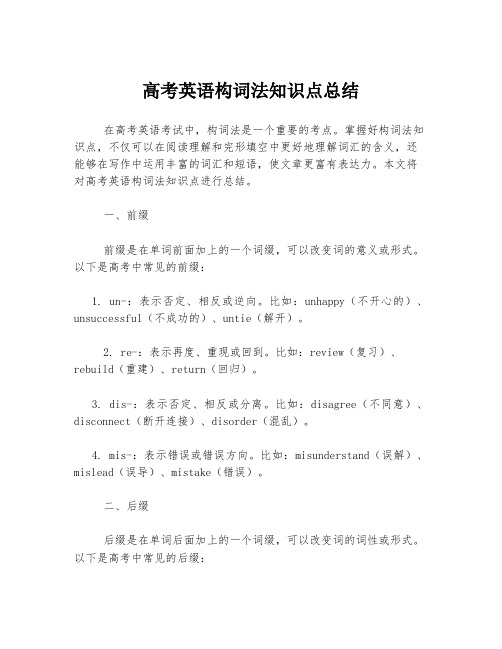
高考英语构词法知识点总结在高考英语考试中,构词法是一个重要的考点。
掌握好构词法知识点,不仅可以在阅读理解和完形填空中更好地理解词汇的含义,还能够在写作中运用丰富的词汇和短语,使文章更富有表达力。
本文将对高考英语构词法知识点进行总结。
一、前缀前缀是在单词前面加上的一个词缀,可以改变词的意义或形式。
以下是高考中常见的前缀:1. un-:表示否定、相反或逆向。
比如:unhappy(不开心的)、unsuccessful(不成功的)、untie(解开)。
2. re-:表示再度、重现或回到。
比如:review(复习)、rebuild(重建)、return(回归)。
3. dis-:表示否定、相反或分离。
比如:disagree(不同意)、disconnect(断开连接)、disorder(混乱)。
4. mis-:表示错误或错误方向。
比如:misunderstand(误解)、mislead(误导)、mistake(错误)。
二、后缀后缀是在单词后面加上的一个词缀,可以改变词的词性或形式。
以下是高考中常见的后缀:1. -er/-or:表示人或物的职业或身份。
比如:teacher(教师)、actor(演员)、visitor(访客)。
2. -ing:表示动作进行中或状态。
比如:running(跑步的)、falling(下落的)、sleeping(睡觉的)。
3. -able/-ible:表示可行的或可接受的。
比如:usable(可用的)、visible(可见的)、credible(可信的)。
4. -ful:表示充满或具有的特性。
比如:beautiful(美丽的)、wonderful(美妙的)、helpful(有帮助的)。
三、词根词根是单词中最基本的部分,可以通过添加前缀或后缀来构成新的单词。
以下是高考中常见的词根:1. log-:表示言论或思考。
比如:dialogue(对话)、logic (逻辑)、monologue(独白)。
构词法-备战2023年高考英语复习语法知识点全面梳理(全国通用)

副词+现在分词 hard-working, far-seeing, well-meaning
副词+过去分词 well-prepared, quickly-cured, well-known
3.3 合成法
复合名词的构成
方式
例词
名词+名词 形容词+名词 动名词+名词 动词+副词 动词+名词
horseback , bank-note, newspaper, cell-phone back-yard, forehead, greenhouse, blackboard hiding-place, reading-room get-off, break-in, breakdown, breakup pickpocket , break-water
词类 数词 副词
后缀 -teen -ty -th -ly
例词 thirteen 十三 fifteen 十五 twenty 二十 fifth 第五 carefully 细心地 happily 开心地
3.2 转化法
3.3 合成法
复合形容词的构成
方式
例词
形容词+名词
first-class, part-time, second-hand, bare-foot
常用后缀 词类
形容词
后缀
-able, -ible
-al -ed -en -ern
-ing
例词
comfortable舒服的 enjoyable 快乐的 flexible灵活的
traditional 传统的 national 民族的 surprised 感到吃惊的 wooden 木制的 golden 金的 eastern 东方的 western 西方的
专题05构词法(讲义)

专题05 构词法(讲义)目录考点构词法2页2页3页【真题研析·规律探寻】3页考向1常考的否定前缀3页考向2考查高频前缀5页考向3考查表示人的后缀6页考向4考查名词后缀7页考向5考查形容词、副词后缀8页考向6考查动词后缀9页考向7考查合成词9页【核心提炼·考向探究】10页1.常考的构词法前缀10页2.常考的构词法后缀11页3.常考的合成词及复合词14页【题型特训·命题预测】15页预测考向1 考查阅读理解中根据构词法猜测词义15页预测考向2 在语法填空中考查构词法15页考点构词法考情分析:分析20212023年新高考有关构词法的考向分布。
近年来,高考对构词法的考查越来越多,2023年的阅读理解中出现的最多,这足以说明构词法对学生推断词义的重要性。
猜测词义1.(2023•浙江1月考)The author’s father disapproved of buying groceries with jars.【答案】不同意,不赞成【解析】考查构词转换。
句意:作者的父亲不赞成用罐子买食品杂货。
2.(2023·新高考全国Ⅱ卷)More recently, as books have bee inexpensive or even throwaway, artists have used them as the raw material for artworks—transforming covers, pages or even plete volumes into paintings and sculptures.【答案】便宜的【解析】考查构词转换。
句意:最近,随着书籍变得便宜甚至一次性,艺术家们把它们作为艺术品的原材料——把封面、页数甚至完整的书转换成绘画和雕塑。
3.(2023·新高考全国Ⅱ卷)The flight was uneventful, and Tiffy was a great passenger.【答案】顺利的,平凡的,平安无事的【解析】考查构词转换。
六大英语构词法详解
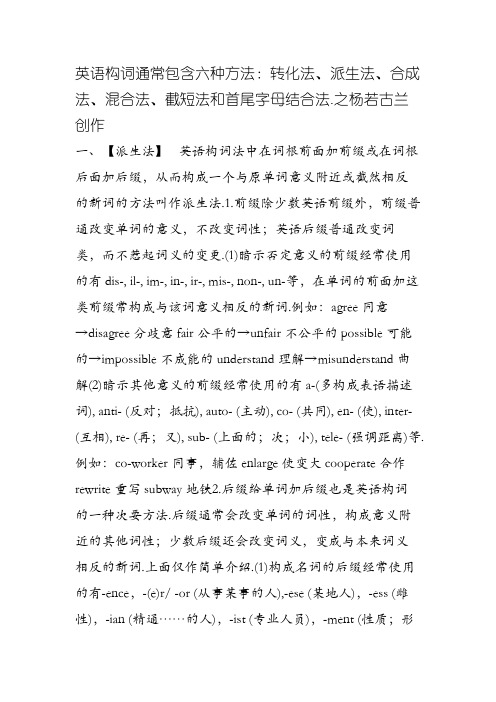
英语构词通常包含六种方法:转化法、派生法、合成法、混合法、截短法和首尾字母结合法.之杨若古兰创作一、【派生法】英语构词法中在词根前面加前缀或在词根后面加后缀,从而构成一个与原单词意义附近或截然相反的新词的方法叫作派生法.1.前缀除少数英语前缀外,前缀普通改变单词的意义,不改变词性;英语后缀普通改变词类,而不惹起词义的变更.(1)暗示否定意义的前缀经常使用的有dis-, il-, im-, in-, ir-, mis-, non-, un-等,在单词的前面加这类前缀常构成与该词意义相反的新词.例如:agree同意→disagree分歧意fair公平的→unfair不公平的possible可能的→impossible不成能的understand理解→misunderstand曲解(2)暗示其他意义的前缀经常使用的有a-(多构成表语描述词), anti- (反对;抵抗), auto- (主动), co- (共同), en- (使), inter- (互相), re- (再;又), sub- (上面的;次;小), tele- (强调距离)等.例如:co-worker 同事,辅佐enlarge 使变大cooperate 合作rewrite 重写subway 地铁2.后缀给单词加后缀也是英语构词的一种次要方法.后缀通常会改变单词的词性,构成意义附近的其他词性;少数后缀还会改变词义,变成与本来词义相反的新词.上面仅作简单介绍.(1)构成名词的后缀经常使用的有-ence,-(e)r/ -or (从事某事的人),-ese (某地人),-ess (雌性),-ian (精通……的人),-ist (专业人员),-ment (性质;形态),-ness (性质;形态),-tion(动作;过程)等.例如:differ 分歧于→diff erence区别write写→writer作家China中国→Chinese中国人act扮演→actress女演员music音乐→musician音乐家(2)构成动词的后缀经常使用的有-(e)n (多用于描述词以后),-fy (使……化),-ize (使……成为).例如:wide→widen加宽beauty→beautify美化pure→purify提纯real→realize认识到organ→organize组织sharp→sharpen使变锋利(3)构成描述词的后缀经常使用的有-al,-able (有能力的),-(a)n(某国人的),-en (多用于暗示材料的名词后),-ern (方向的),-ese(某国人的),-ful,-(ic)al,-ish,-ive,-less (暗示否定),-like (像……的),-ly,-ous,-some,-y (暗示天气)等.例如:nature天然→natural天然的reason道理→reasonable有道理的America美国→American美国的China 中国→Chinese中国人的gold金子→golden金的east东→eastern东方的child孩子→c hildish孩子气的snow雪→snowy雪的(4)构成副词的经常使用后缀有-ly (次要用于描述词以后暗示方式或程度),-ward(s) (次要用于暗示方位的词以后暗示方向).例如:angry生气的→angrily生气地to到→towards朝……,向……east东方→eastward向东(5)构成数词的后缀有-teen (十几),-ty (几十),-th (构成序数词).例如:six六→sixteen十六→sixteenth第十六four四→forty四十→fortieth第四十二、【合成法】英语构词法中把两个单词连在一路合成一个新词,前一个词润色或限制后一个词,如许的方法就是合成法.1.合成名词名词+名词weekend周末名词+动词daybreak黎明名词+动名词handwriting书法名词+及物动词+er/or pain-killer止痛药名词+介词+名词sister-in-law嫂子代词+名词she-wolf母狼动词+名词typewriter打字机动名词+名词reading-room阅览室此刻分词+名词flying-fish飞鱼描述词+名词freshman大一重生副词+动词outlook景色,风光介词+名词afterbrain后脑2.合成描述词名词+描述词bloodred血红的名词+此刻分词French-speaking讲法语的名词+to+名词one-to-one一对一的名词+过去分词man-made人造的数词+名词one-way单行道的数词+名词+描述词three-year-old三岁的数词+名词+ed ten-storeyed十层的动词+副词one-off 一次性的描述词+名词high-quality高质量的描述词+名词+ed noble-minded高尚的描述词+描述词light-green浅绿色的描述词+此刻分词ordinary-looking边幅普通的副词+描述词ever-green常青的副词+此刻分词hard-working辛苦的副词+过去分词well-known闻名的副词+名词fast-food专门提供快餐服务的介词+名词indoor室内的3.合成动词名词+动词sleep-walk梦游描述词+动词white-wash粉刷副词+动词overwhelm压服,礼服4.合成副词描述词+名词hotfoot匆忙地描述词+副词everywhere到处副词+副词however尽管如此介词+名词beforehand事先介词+副词forever永久5.合成代词代词宾格+self herself 她本人物主代词+self myself 我本人描述词+名词anything 一切6.合成介词副词+名词outside在……里面介词+副词within在……以内副词+介词into进入三、【转化法】英语构词法中把一种词性用作另一种词性而词形不变的方法叫作转化法,有的名词可以作动词,有的描述词可以作副词或动词.1.动词转化为名词1)意思没有变更,例如:I think we'd better finish the talk now.我想我们的谈话最好此刻结束.2)意思有必定变更,例如:He is a man of strong build.他是一个体格健壮的汉子.3)构成短语,例如:Let's have a look first. 我们先看一下吧.2.名词转化为动词1)暗示物体的,如:Have you booked the ticket?你订好票了吗?2)暗示身体部位的,如:Hand in your papers please.请把你们的试卷交上来.3)暗示一类人的,如:She nursed her husband back to health.她看护丈夫,使他恢复了健康.4)抽象名词,如:We breakfasted together.我们在一路吃了早饭.3.描述词转化为动词少数描述词可以转化为动词.例如:We will try our best to better our living conditions.我们要尽力改善我们的生活情况.4.副词转化为动词有少数副词可以转化为动词.例如:Murder will out.恶事终势必败露.5.描述词转化为名词1)暗示色彩的描述词常可转化为名词,如:The girl in black appears very beautiful.那个穿黑衣服的女孩子看上去非常漂亮.2)一些描述词如old, young, poor, rich, wounded, injured等与the连用,暗示一类人,作主语时,谓语用复数,如:We don't belong to the rich, but we dong't belong to the poor either. 我们不是有钱人,但我们也不是穷人.四、【截短法(缩略法)】将单词缩写,词义和词性坚持不变的英语构词法称为截短法,次要有截头、去尾、截头去尾等方式.1.截头telephone→phoneairplane→plane2.去尾mathematics→mathsexamination→examkilogram→kilolaboratory →labtaxicab→taxi3.截头去尾influenza→flurefrigerator→fridgeprescription→script五、【混合法(混成法)】英语构词还可以将两个词混合或各取一部分紧缩而成一个新词,前半部分表属性,后半部分表主体.如许的英语构词法就是混合法.newsbroadcast→newscast旧事广播television broadcast→telecast电视广播smoke and fog→smog烟雾photo andgraphy→photography摄影,摄影术helicopter airport→heliport 直升飞机场六、【首尾字母缩略法】用单词首尾字母构成一个新词的英语构词法叫做首尾字母缩略法.这类方式的英语构词生成的新词,读音次要有两种方式,即各字母分别读音;作为一个单词读音.Testing of English as a ForeignLanguage→TOEFL托福Teach English as a Foreign Language→TEFLTeach English as a SecondLanguage→TESLGraduate Record Examination→GRE美国研讨生入学考试1、名词: 可数(1)把握名词复数方式的构成①直接在词尾 + s(boys, pencils)②以ch, sh, s, x结尾的 + es(watches, buses)③以“辅音字母+ y”结尾的, 变y为i + es(families, cities)④以f, fe结尾的, 变f, fe为v + es(knives, leaves)⑤不规则变更(children, women, fish, tomatoes)留意①单复数同形的名词: sheep, Chinese, Japanese.②只要复数方式的词: people, trousers, clothes, thanks.(2)把握名词的所有格的两种暗示法①有生命的人或动物的所有格常在单词后边加's②无生命的事物的所有格用of.my mother's bag the dog's house the door of our classroom留意, 加's构成所有格时, 如果名词本人是以s结尾的则只加', 不加s.(3)不成数名词①不成数名词没有复数方式, 且前边不克不及用不定冠词, 也不克不及用数词作定语.②作主语时, 谓语动词用单数方式.③使用量词短语暗示数量.a piece of news a cup of tea2、冠词(1)把握不定冠词a和an的用法用在第一次提到的可数名词单数前或泛指一类人或物及固定词组中.(2)把握定冠词the的用法①用来特指某人或某物.②用活着界上独一无二的事物的名称前.③用在序数词和描述词第一流前.④用在姓氏的复数方式前, 暗示夫妇或一家人.⑤某些词组中的固定搭配.3、代词(1)分清人称代词的主格和宾格的用法①主格在句子中作主语.②宾格在句子中作宾语.(2)分清描述性物主代词和名词性物主代词的用法①描述词性物主代词后边必须跟着它所润色的名词.②名词性物主代词后边不克不及再跟名词.(3)反身代词的构成和用法反身代词在句中次要起强调感化, 词组有teach oneself, learn by oneself(4)把握以下不定代词的基本用法①some——一些.经常使用于肯定句, 可润色可数名词和不成数名词.any——一些, 任何.经常使用于任何否定句, 疑问句条件句中, 可润色可数名词和不成数名词.留意与some或any组合生成的词(something, somebody, someone, anything, anybody, anyone), 其用法与some和any基底细同.②each——可单独使用, 强调个体, 用于两者或两者以上的每个人或物, 可作名词和描述词使用.every——不成单独使用, 强调全体, 用于三者或以上的情况, 只能作描述词用.③both, all, neither, none, either, any, the other的区别.含义对象都都不任何(一个) 每(一个) 另(一个)two both neither either each the otherthree all none any every another(5)初步把握it用来暗示天然景象、时间、距离及作方式主语或方式宾语的用法.It's 3 o'clock in the afternoon.It's about 5 kilometres away.It's raining now.It's important to learn English well.You'll find it easy to make a kite.4、数词(1)把握基数词和序数词的构成及基本用法.留意以下几个序数词的写法:first, second, third, fifth, eighth, ninth, twelfth, twentieth, thirty-first one hundredth(2)把握千以内数字的写法:8, 231 eight thousand two hundred and thirty-one(3)把握年、月、日的表达法及日常交际用语中数字的表达法:(on) August seventh, 1979; page 58; Unit25; Class Three Grade One; the No.168 Middle School(4)把握以下词组的用法:hundreds of, thousands of, millions of, three hundred students 5、描述词和副词(1)描述词和副词的原级、比较级和第一流的构成及使用.①原级: 没有比较用原级, 特定句型用原级(as…as, not as…as, not so…as).②比较级: 两者比较用比较级, 句中有"A or B"句型或than.③第一流: 三者或三者以上比较用第一流, 句中有"A, B or C"句型或由in或of引出比较范围.④其它表达法: 比较级 + and + 比较级表“愈来愈……”, The + 比较级, the + 比较级表“越……越……”eg: ①Mike is tall.This room is as big as that one.This lesson isn't as interesting as lesson Three.Tom doesn't run so fast as Jack.②Which is b etter, this one or that one?My sister writes more carefully than my brother.③Who is the tallest, Jack, John or Tom?He is the most careful in our class.Changjiang River is the longest river in China.④Spring is coming. It's getting warmer and warmer.The barder he studied, the more knowledge he got.⑤描述词副词比较级和第一流的构成a、直接 + er / + estb、以e结尾的 + er / + estc、以辅音字母 + y结尾的变y为i + er / + estd、重读闭音节以一个辅音字母结尾的, 双写 + er / + este、不规则变更f、多音节和少数双音节的词, 在词前加more或most(2)易混的副词辨析:①already, 多用于肯定句, yet多用于否定句或疑问句中②to o, also, either都暗示“也”too和also都用于肯定句中, too常放在句尾, also常放在句中, either用于否定句的句尾.6、介词(1)暗示时间的介词in, on, atin——用于较长一段时间, 礼拜, 月份, 季节, 年, 朝代世纪或非特指的早、午、晚等.on——具体某一天或具体某一个早、午、晚.at——在某一点时间或某个瞬间.eg: in 1988, in the 21st century, in winter, in March, in the moring, on Saturday evening, on the May seventh, on a windy night, on the afternoon, of October 31st, at eight o'clock, at night, at noon, at the end of, at this moment, at this time, at the age of(2)in与after暗示“当前”时的区别in——暗示以此刻为起点的“当前”, 经常使用于将来时态中.after——经常使用于普通过去时态中, 暗示在过去某个时间以后.eg: We'll come back in two weeks.我们将在两周后回来.They came back after two weeks.两周当前, 他们回来了.(3)ago与before暗示“在……之前”时的区别ago——暗示从此刻算起的“之前”, 经常是“一段时间 + ago”before——暗示以过去为起点的“之前”时, 经常是“一段时间+ before”, 如果是:”“before + 一点时间”, 则只暗示在某一点之前.eg: He went to the library 2 hours ago.He said he had gone to the library 2 hours before.They will start before eight o'clock tomorrow morning.I went to bed before nine yesterday evening.(4)for与duringfor + 一段时间常暗示“持续了一段时间”, 而during则暗示在……期间eg: He has been in Beijing for 3 years.I was in Beijing during last summer.(5)in与at暗示方位时at——与小的地点连用, 有“在某一点”的含义.in——与大的地方连用有“在…范围以内”的含义.He was lost at the station.The twins were born in a big city.(6)over, above与on暗示“在……上”的区别. over——指没有接触面的正上方, 反义词是under. above——指没有接触面的上方, 在高一些的地位, 反义词是below.on——指有接触面的, 在……的概况上.The plane is above the clouds.The bridge is over the river.The cup is on the table.(7)熟练把握介词与动词、名词、描述词搭配构成的词组, 另外还要留意, 介词的后边要跟名词作它的宾语, 如果是动词, 则要变成动名词(doing)的方式.如: She is good at singing.I'm good at English.7、连词(1)把握连词的含义与用法and(和, 并), but(但是), or(否则, 或者), so(所以, 因而),when(当……的时候), either…or(或者……或者, 不是……就是), neither…nor(既不……也不……), so…that(如此……乃至于……)8、动词(1)熟练把握动词的此刻分词, 第三人称单数, 过去式, 和过去分词的构成.留意牢记不规则动词的过去式和过去分词.(2)把握四类动词的普通用法:①实义动词——分为及物和不及物两种, 在句中作谓语.②连系动词——be, look, feel, get, turn, become, keep等, 在句中与表语一路构成相当于谓语部分的系表结构.③助动词——帮忙谓语动词构成分歧的时态和否定句, 疑问句, 不克不及单独使用, 也无含义.④情态动词——可以说是一种特殊的助动词, 情态动词没有人称和数的变更, 后边必须跟动词本相, 而且本人不单有含义而且可以直接构成否定句和疑问句.(3)非谓语动词的习气用法, 必定要熟记1)begin to do sth 2)start to do sth3)decide to do sth 4)want to do sth5)(would) like to do sth 6)forget to do sth7)remember to do sth 8)love to do sth9)learn to do sth 10)need to do sth11)try to do sth 12)try not to do sth13)stop to do sth 14)ask sb.to do sth15)ask sb.not to do sth 16)like sb.to do sth17)teach sb.to do sth 18)tell sb.to do sth19)tell sb.to do sth 20)want sb.to do sth21)help sb.(to) do sth 22)let sb.do sth23)have sb.do sth 24)make sb.do sth25)had better do sth 26)had better not do sth27)feel / hear sb.do sth 28)watch / see sb.do sth29)why not do sth 30)be busy doing sth31)see / watch sb doing sth 32)feel / hear sb doing sth33)enjoy doing sth 34)finish doing sth35)keep (sb) doing sth 36)go on doing sth37)stop doing sth 38)like doing sth39)begin doing sth 40)start doing sth41)prevent sb from doing 42)stop sb / sth from doing sth 43)spend时间 / 金钱(in) doing sth 44)It takes sb. some time todo sth.45)It is good (wrong, easy, difficult, important…) to do sth46)It is time (for sb.) to do sth 47)be used for doing sth 48)will / would you please do sth 49)what about (doing) sth (4)能够区别使用以下动词1)tell, say, speak, talk2)bring, take, carry3)lend, borrow, keep4)listen, listen to, hear, hear from, hear of5)look, look at, see, watch, notice6)reach, arrive(in / at), get to7)look for, look after, look at, look up8)put on, put up, put down, put away, put into9)look for, find, find out, found10)take off, take away, take down11)try on , put on, wear, dress, get dressed12)ask for, send for13)get back, give back, take back14)be made in, be made of, be made from, be made by15)get on, got off, get into, get out of16)get in, get up, get on…with17)go down, go on, go out18)look out, look out of19)turn on, turn off, turn up, turn down, turn to, turn over20)send out, sent to , send away, send up, send for21)fill…with… be full of… be filled with…23)be in, be out, be away, be over, be up24)wear out, sell out25)worry about the worried about26)cost, pay, spend, take(5)留意延续性动词(段动词)与瞬间动词(点动词)在用法上的区别.瞬间动词有: join, buy, come, go, leave, arrive, begin, start, open, closed, become, borrow, lend, die, get等.记住: 瞬间动词(点动词)不克不及与暗示持续一段时间的时间状语连用.。
词汇分析知识点总结

词汇分析知识点总结词汇分析是语言学中一个重要的领域,它涉及到词的形态、构词、词义、词汇关系等方面的研究。
词汇分析是词汇学研究的基础,对于语言学、语言教学、翻译等方面都具有重要的意义。
本文将对词汇分析的相关知识点进行总结,包括词的形态、构词法、词义和词汇关系等方面的内容。
一、词的形态词的形态是指词的内部构造和组成方式。
根据构词成分的不同,词可以分为单词、复合词、派生词和派生词等。
单词是最基本的词汇单位,不可再分解为其他构词成分,如man、cat等。
复合词是由两个或多个单词构成的词,如blackboard、butterfly等。
派生词是通过在词根、词干或词缀上加上前缀、后缀或引申等方式构成的词,如happiness、unhappy等。
组合词是由两个或多个词汇组合而成的词,如airplane、sunset等。
二、构词法构词法是研究词的构成和变化规律的学科,包括派生、合成、转化等构词方式。
派生是指通过在词根、词干或词缀上添加前缀、后缀或引申等方式构成新词的方式,如happy → happiness。
合成是指将两个或多个词组合起来构成新词的方式,如air + port → airport。
转化是指通过词性转换构成新词的方式,如teach → teacher。
三、词义词义是指词汇所表达的概念或含义。
词义可以通过词的内部成分、上下文、语法关系等方式来确定。
词义分为词的本义和引申义。
词的本义是词的最基本的意义,是词的最初的意义,如apple的本义指水果。
引申义是词在使用过程中产生的转义或引申出来的新的意义,如apple在口语中可以表示“头”。
四、词汇关系词汇关系是指词与词之间的关系,包括近义词、反义词、同根词、异形词等关系。
近义词是指意义相近的词,如big和large、happy和glad等。
反义词是指意义相对的词,如big 和small、happy和unhappy等。
同根词是指具有相同词根的词,如happy和happiness。
英语基本构词法知识点讲解

英语基本构词法知识点讲解构词法是研究词的内部结构和形成的学科,在英语学习中占据了重要的地位。
了解英语的构词法知识点能够帮助我们更好地理解、记忆和运用词汇。
本文将就英语的基本构词法知识点进行讲解。
一、构词法概述构词法是指研究词的构成和形变的规律,它主要涉及词根、前缀、后缀和词缀等。
通过对构词法的学习,我们可以了解到很多单词的内在含义和变形规则,从而更加灵活地运用词汇。
二、词根词根是单词的基本部分,是构成单词的核心,也是其他构词成分的基础。
词根通常没有变化,它们的意义比较稳定。
比如,“tele-”(远程)是一个常见的词根,可以在很多单词中找到,比如“telephone”(电话)、“television”(电视)等。
三、前缀前缀是附加在词根之前的构词成分,它可以改变词的意义或词性。
英语中有很多常见的前缀,比如“un-”(表示否定或相反)、“re-”(表示再次)、“dis-”(表示相反)等。
通过添加前缀,我们可以扩展词汇的含义和用法。
例如,“happy”(快乐的)添加前缀“un-”后变成“unhappy”(不快乐的)。
四、后缀后缀是附加在词根之后的构词成分,它可以改变词的词性、数目和形态等。
英语中有很多常见的后缀,比如“-er”(表示人或物体)、“-ful”(表示充满的)、“-ize”(表示使……化)等。
通过添加后缀,我们可以将一个词转变为名词、动词或形容词。
例如,“child”(孩子)添加后缀“-ish”后变成“childish”(孩子气的)。
五、词缀词缀是指前缀和后缀的统称,它们可以独立存在也可以相互结合。
词缀的运用可以让我们更加灵活地构造词汇,提高表达的准确度和多样性。
六、派生词派生词是指通过添加前缀、后缀或词缀而形成的新词。
在英语中,很多单词都是由其他单词派生而来的。
例如,“happiness”(幸福)由“happy”(快乐的)加后缀“-ness”(表示状态或品质)而成。
七、复合词复合词是由两个或更多个词组合而成的新词。
2022年高考英语复习一轮:专题十二构词法 —课标导航、考点清单
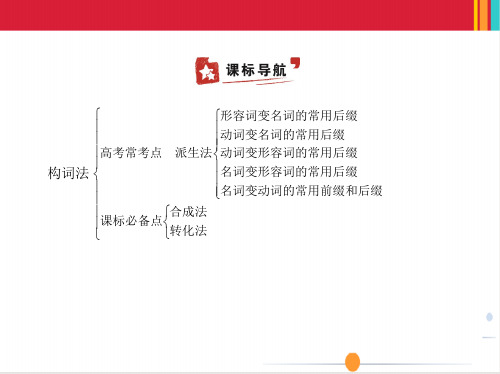
3.其他形式的合成词
合成动词 合成代词 合成副词 合成介词
类别
典例 safeguard保卫,underline强调,sleepwalk梦游 everybody每人,everything每件事,anyone任何人 sometimes有时,outdoors在户外,meanwhile同时 throughout遍及,inside在里面,within在……之内
一、形容词变名词的常用后缀
常用后缀 -age -cy -dom -ence
例词 short→shortage不足;短缺 efficient→efficiency效率;功效 fluent→fluency流利;流畅
free→freedom自由;自主
wise→wisdom明智;智慧
different→difference 差异
four-footed四只脚的 full-time全日的 dark-blue深蓝的
three-legged 三条腿的 high-class高级的 light-green浅绿的
形容词+名词+-ed 形容词/副词+动词-ing 形容词/副词+动词-ed 名词+形容词 名词+动词-ing 名词+动词-ed
hear→hearing听力;听觉 begin→beginning开始
fail→failure失败 press→pressure压力 mix→mixture混合;混合物 depart→departure离开;出发
续表
续表
-y
recover→recovery恢复;痊愈
discover→discovery发现
其他
choose→choice选择 vary→variety多样化;种类 tend→tendency趋向;趋势
- 1、下载文档前请自行甄别文档内容的完整性,平台不提供额外的编辑、内容补充、找答案等附加服务。
- 2、"仅部分预览"的文档,不可在线预览部分如存在完整性等问题,可反馈申请退款(可完整预览的文档不适用该条件!)。
- 3、如文档侵犯您的权益,请联系客服反馈,我们会尽快为您处理(人工客服工作时间:9:00-18:30)。
重点专题构词法归纳1.派生法(1)前缀①表示否定意义的前缀:a. 纯否定前缀:un-: unable, unemployment(失业), unload(卸载), uncover(揭开), unhappy, untrue, unlike (不像), unrest(不安的,动荡的), unfair, unknown, unhealthy, unusual, uncertain, unclear(不清楚的), unequal, unlucky, unreal, unkind, uncomfortable, uneasy(心情不安的), uninteresting, unimportant, unnecessary, unpleasant, undivided, unreserved(无保留的)dis-: dislike(不喜欢), disarm, disconnect, disagree, disappear, disadvantage, dishonest, disability, discover(发现), disobeyin-, im-, il-, ir-: incapable, inability, incomplete, incorrect, inconvenient, inexpensive, impossible, immoral(不道德的), illegal(非法的), illogical(不合乎逻辑的), irregular, irrelative non-: non-smoker, non-stop, non-violent(非暴力的), nonwhite, non-member, nonparty(无党派), nonsense(无意义)b. 表示错误的意义:mis-: mistake, mislead(误导), misunderstanding, misuse, mis-spell, mistrust, mistreatc. 表示“反、防、抗”的意义:anti-: antiknock(防震), antiforeign(排外的), anti-war, antitank(反战车的), anti-pollution②表示空间位置、方向关系的前缀:a- 表示“在……之上”,“向……”:aboard, asidede- 表示“在下,向下”:decrease(下降), degradeen- 表示“在内,进入”:encage(入笼), enbed(上床)ex- 表示“外部,外”:exit, expand(扩张), exportfore- 表示“在前面”:forehead, foreground, foreleg, forefootin-, im- 表示“向内,在内,背于”:inland, inside, indoor(s), importinter- 表示“在……间,相互”:international, interaction, internet, interviewmid- 表示“中,中间”:midpositionout- 表示“在外部,在外”:outline, outside, outward(s), outdoor(s)over- 表示“在上面,在外部,向上”:overlook, overhead, overboard, overcoat, overdress, oversea(s)(海外)post- 表示“向后,在后边,次”:postscript(附言)pre- 表示“在前,在前面,提前”:prefix(前缀), preface(前言), preposition(介词)super- 表示“在…..之上,超级”:superstructure, supernatural, superpower, supermantrans- 表示“移上,转上,在那一边”:translate, transform(转移), transplant(移植), transportation(交通)under- 表示“在…..下面,下的”:underline, underground, underwater, undershirtup- 表示“向上,向上面,在上”:upward(s), uphold, uphill(上坡)auto- 表示“自己,独立,自动”:automobile(自动车), autobiography(自传)tele- 表示“远离”:television, telephone , telegram(电报), telegraph(电报,抽象名词), telescope(望远镜)③表示时间,序列关系的前缀:fore- 表示“在前面,先前,前面”:foreword(前言), forecast(预报), foretell(预言), foresee(预见), foreknow(先知), foreknowledge(先知)mid- 表示“中,中间”:midnight, midsummer, mid-day, mid-autumnpost- 表示“在后,后”:postwar, postgraduate(研究生), postdatepre- 表示“在前,事先,预先”:preheat, prewar, prehistory(史前), preview(预习), prebattle, prepayre- 表示“再一次,重新”:retell(复述), rewrite, renew(续借), reconsider, reuse, remarry, recycle(回收利用), rebuild④表示比较程度差别关系的前缀:by- 表示“副,次要的”:byproduct(副产品), bywork(副业)extra- 表示“超越,额外”:extraordinaryover- 表示“超过,过度,太”:overeat(吃过多), oversleep(睡过头), overpraise(过奖), overwork, overact(行为过分), overdounder- 表示“低劣,低下”:undersize, undergrown, underproduction(生产不足)vice- 表示“副,次”:vice-president, vice -chairman⑤表示共同,相等意思的前缀:co- 表示“共同,一起”:coexist(共同生存), co-operate, co-worker, coactions(合作行动), coauthor(合作作者)⑥表示某种状态,构成形容词、副词或动词:a- afraid, alive, alone, asleep, ashamed, aloud, ahead, aside, alike, awake⑦表示分离,离开意思的前缀:a- 表示“分离,离开”:away, apartde- 表示“离去,处去”:depart, decolour⑧表示“自我”:self- self-protect(ion), self-made, self-knowledge⑨表示变换词类作用的前缀:be- befrienden- enslave, enable, enrich, enlarge, encourage⑩表示数量关系的前缀:a. 表示“单一”,“一”:uni- uniform(统一服装), unicellular(单细胞)b. 表示“二,两,双”:bi- bicycletwi- twilightc. 表示“半,一半”:semi- semiconductor(半导体), semicircle(半圆), semimonthly(半月刊), semifinal (半决赛)d. 表示“百,百分之一”:centi- centimetere. 表示“千,千分之一”:kilo- kilometer, kilogram, kilowattf. 表示“微小”:micro- microvolt(微伏特), microcomputer(微机), microscope(显微镜)g. 表示“许多,复,多数”:multi- multimedia(多媒体), multicolored, multiform, multinaturalh. 表示“千分之一、毫”:milli- millimeter, milligrami. 表示“微小、微型”:mini- minibus, miniskirt, minipark(2)后缀①名词后缀:a. 具有某种职业或动作的人:-an, -ian, -ician 表示“……地方的人,精通……的人”:American, Asian, Australian, Russian, Italian , historian, librarian, electrician, magician(魔术师), technician, musician, politician(政客), physician(内科医生),-ant,-ent 表示“……人”:merchant, servant, assistant, agent, student,-ee 表示“动作承受者”:employee(雇员), examinee, payee(收款人), interviewee -eer 表示“从事于……人”:engineer, volunteer(志愿者)-er 表示“从事某种职业的人, 某地区,地方的人”:banker, observer, Londoner, villager singer, driver, writer, speaker, traveller, buyer-or 表示“……者”:author, doctor, operator, actor, visitor, inventor, educator-ar, -ary 表示“……的人, 从事……的人”:scholar, liar, beggar, secretary, missionary -ese 表示“……国人,……地方的人”:Chinese, Japanese, Cantonese(广东人)-ess 表示“阴性人称名词”:actress(女演员), hostess(女主人), manageress(女经理)-ist 表示“从事……研究者,信仰……主义者”:pianist, communist, dentist, artist, chemist, socialist, typist, receptionist-icist 表示“……家,……者, ……能手”:physicist, phoneticist(语音学家), technicist -logist 表示“……学家,研究者”:biologist, geologist(地质学家)b. 构成具有抽象名词的含义:-age 表示“状态,行为,身份及其结果,总称”:courage, storage, marriage, percentage -al 表示“事物的动作,过程”:refusal, arrival, survival, denial, approval, trial, burial-ance, -ence 表示“性质,状况,行为,过程,总量,程度”:importance, distance, avoidance, appearance, performance, diligence, difference, obedience, absence, presence(出席), existence -ancy, -ency 表示“性质,状态,行为,过程”:frequency(频繁), urgency(紧急), efficiency (高效率),-ity 表示“性质,状态,程度”:purity, reality, equality-bility 表示“动作,性质,状态”:ability, possibility, probability, responsibility-dom 表示“等级,领域,状态”:freedom, kingdom, wisdom-ery, -ry 表示“行为,状态,习性,性质”:bravery, slavery-hood 表示“资格,身份, 年纪,状态”:childhood, girlhood, boyhood, manhood-ice 表示“行为,性质,状态”:notice, justice, service-ing 表示“动作的过程,结果”:building, writing, learning-ion, -ation, -ition, -sion 表示“行为的过程,结果,状况”:suggestion, action, solution, invention, direction, correction, collection, instruction, destruction, introduction, congratulation, dictation, invitation, pronunciation, examination, graduation, operation, education, information, translation, starvation, satisfaction, relation, irrigation, determination, preparation, imagination, explanation, opposition, competition, description, decision, division, conclusion, explosion,impression, expression, admission, permission, discussion-ment 表示“行为,状态,过程,手段及其结果”:disappointment, treatment, movement, judgment, punishment, argument, agreement, government, development, improvement, requirement, astonishment, encouragement-ness 表示“性质,状态,程度”:goodness, kindness, tiredness, friendliness, business, illness, happiness, goodness, willingness, weakness, fairness-ism 表示“制度,主义,学说,信仰,行为”:socialism, criticism, heroism, tourism, communism(共产主义), Marxism(马克思主义)-ship 表示“情况,性质,技巧,技能及身份,职业”:hardship, relationship, membership, friendship, seamanship, ownership, scholarship, professorship-th, 表示“动作,性质,过程,状态”:strength, length, width, depth, wealth, truth, growth, warmth, youth-ure 表示“行为,结果”:exposure(暴露), pressure, failure, procedure(手续), mixture -craft 表示“工艺”:aircraft, needlecraft, woodcraftc. 带有场所,地方的含义:-age 表示“住所,地点”:village, cottage-ary 表示“住所,场地”:library, granary (谷仓)-ory 表示“工作场所,住处”:factory, dormitory, laboratory, observatory②形容词后缀:a. 带有“属性,倾向,相关”的含义:-able, -ible: movable, comfortable, eatable, enjoyable, acceptable, reasonable, applicable, visible, responsible, terrible, horrible-al: natural, additional, educational, national-ant, -ent: distant, important, excellent-ing(表示特征:令人觉得): moving, touching, daring, interesting, exciting, disappointing , astonishing, boring, amazing-ed(表示情绪:觉得): pleased, interested, surprised, worried, excited, bored, determined, delighted-ish: foolish, bookish, selfish-ive: active, impressive, decisive, active, instructive, expensive, progressiveb. 表示“相象,类似”的含义:-ish: boyish, childish-like: manlike, childlike-some: troublesome, handsome-y: milky, cloudy sunny, windy, rainy, foggy, healthy, wealthy, worthy, bloody, funny, dirty, lucky, noisy, salty, smelly, hilly-ly: manly, fatherly, motherly, sisterly, brotherly, daily, weekly, monthly, quarterly, yearly, friendly, lonely, orderly, lovely, lively, likely, scholarlyc. 表示“充分的”含义:-ful: beautiful, wonderful, helpful, truthful, successful, harmful, useful, careful, forgetful, merciful-ous: dangerous, courageous, nervous, mountainous, humorous, variousd. 表示由某种物质形成,制成或生产的含义:-en: wooden, golden, woolene. 表示方向的含义:-ern: eastern, western, southern, northern, southeastern, northwestern-ward: downward, forwardf. 表示“数量关系”的含义:-teen: thirteen-ty: fifty-th: fourth, fiftiethg. 表示国籍,语种,宗教的含义:-an: Roman, European-ese: Chinese, Japanese-ish: English, Spanishh. 表示否定:-less: countless, stainless(不锈的), wireless, useless, endless, priceless(无价的,贵重的), hopeless③动词后缀:-ize, ise 表示“做成,变成,……化”:modernize(现代化), democratize(民主化), organize, apologize, realize-en 表示“使成为,引起,使有”:quicken, weaken, soften, harden-fy 表示“使……化, 使成”:beautify, purify(净化), intensify, signify, simplify(简化), satisfy④副词后缀:-ly: possibly, swiftly, simply-ward(s): downward, inwards, upward-ways: always, sideways-wise: otherwise, clockwise注意:有的单词有双重后缀,如:use(用途)→useless(无用的)→uselessness(无用)self(自己)→selfish(自私的)→selfishness(自私)有的单词则是前后缀同时使用,如:important→importance→unimportanceregular(有规律的,有规则的)→irregular(无规律的,不规则的)→irregularity(无规律,不规则)2.合成法(1)合成名词boyfriend, girlfriend, bus-driver, necklace, playground, radioactive, headmaster, sunshine, notebook, armchair, wheelchair, postcard, football, spaceship, blackboard, firefighter, fireman, gateman, chairman, weatherman, businessman, armyman, postman, sportsman, bedroom, reading-room, classroom, newspaper, pickpocket(扒手), she-goat(雌性山羊), editor-in-chief (主编), daybreak(破晓), handshake(握手), silkworm(蚕), outbreak(爆发)(2)合成形容词名词+动词过去分词:man-made, homemade副词+动词过去分词:well-known, newly-built(新建的)形容词+名词ed:kind-hearted, cold-blooded数词+名词ed:five-storeyed(五层楼的), four-legged(四条腿的)名词+动词现在分词:English-speaking, Chinese-speaking, brainwashing(洗脑的)由三个词构成的合成形容词:face-to-face, heart-to-heart, two-year-old, eight-metre-long 其他合成形容词:everyday(日常的), faraway(遥远的), snow-white(雪白的), lay-off (下岗的)3.转化法(1)名词→动词hand(手→传递)back(背部,后面→支持,后退)charge(费用→收费)copy(抄本,复印件→抄写,复印)flood(洪水→淹没)heat(热量→加热)paint(油漆→刷漆)phone(电话→打电话)pin(别针→装订)waste(废物→浪费)face(脸→面对)use(用途→使用)interest(兴趣→使兴趣)surprise(惊讶→使惊讶)taste(味道→品尝)smell(气味→闻)break(短暂休息→折断)present(礼物→赠送)(2)形容词→动词clean(干净→使干净,打扫)clear(清楚→清理)dirty(脏→弄脏)dry(干燥→烘干,晒干)empty(空的→倒空)free(自由→使自由,释放)slow(慢的→放慢)warm(暖和→使暖和)cool(凉的→冷却)quiet(安静→使安静)。
